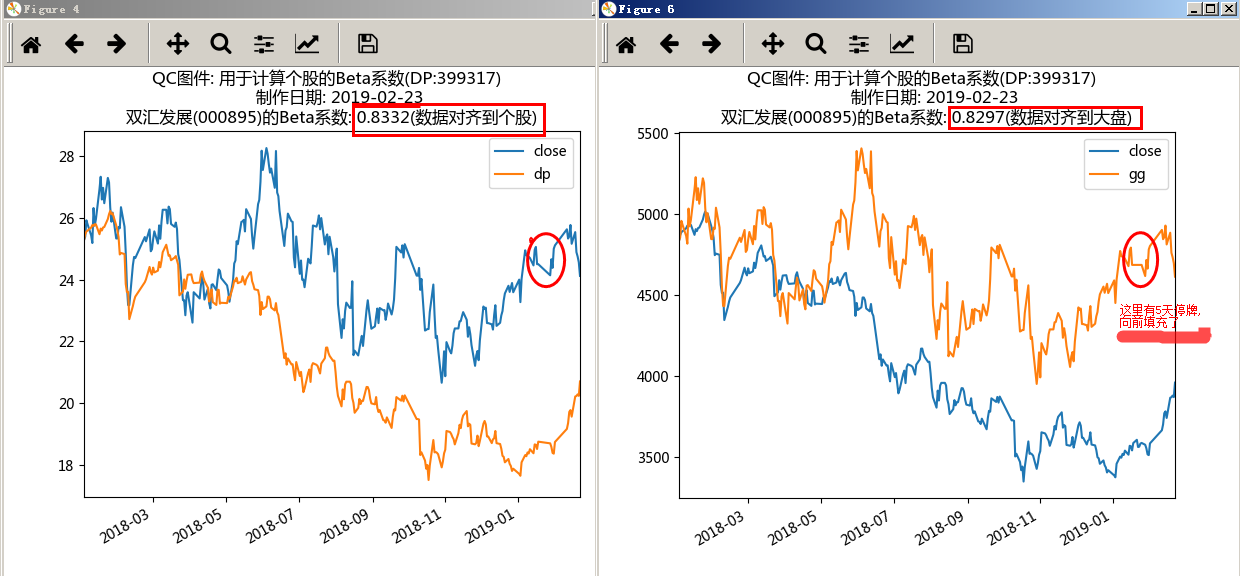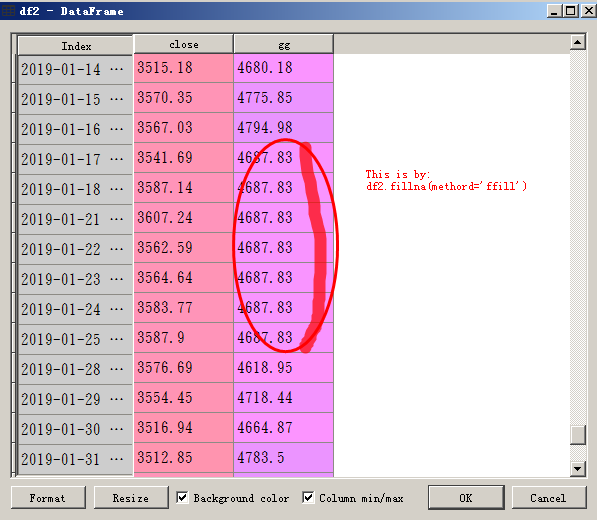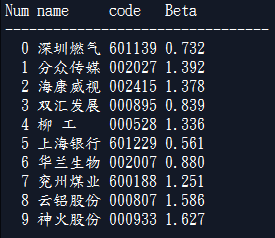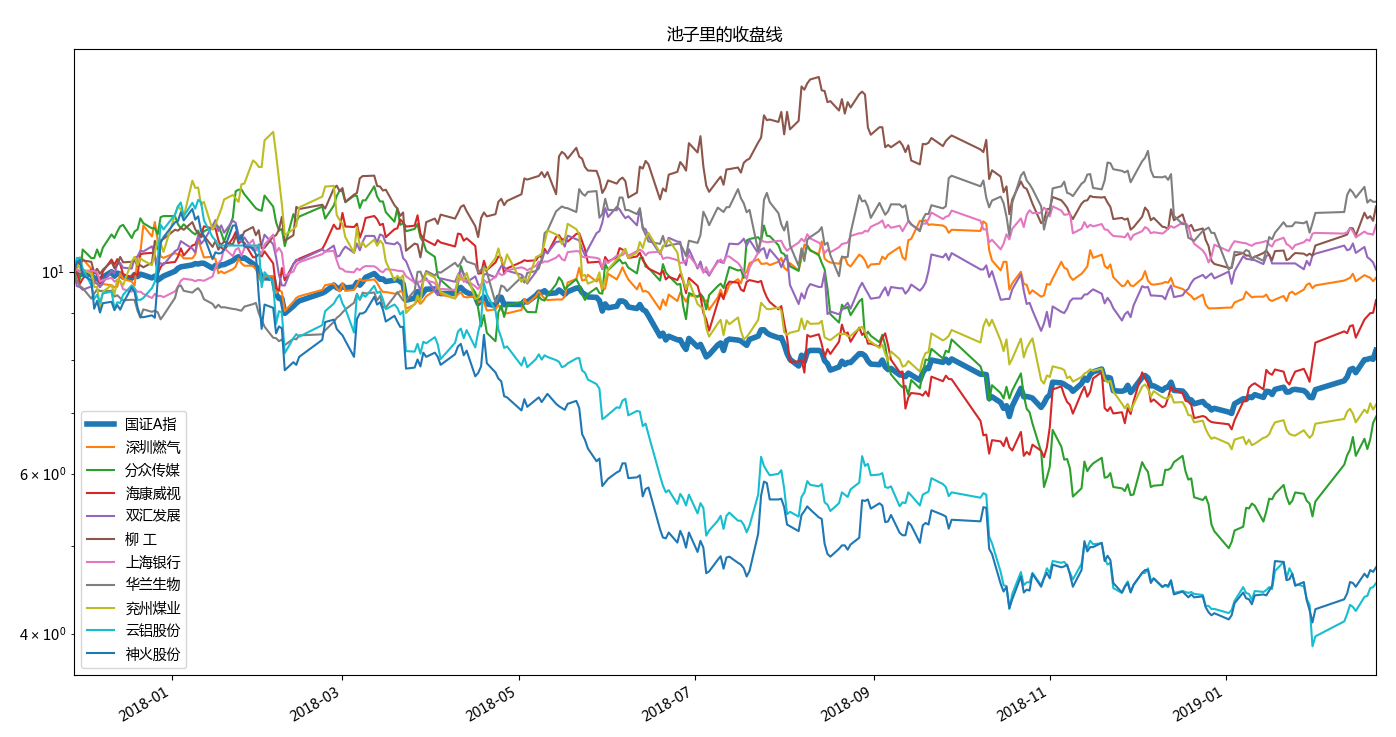个股的beta系数的估算
代码
def test_gg_beta(symbol='000895.sz',
start='2018-01-01',
plot_price=True,
align_to='gg',
plot_k=True,
):
'''
align_to: str, ['gg', 'dp'], 数据对齐的方式
'gg': 表示对齐到个股, 改变大盘的数据, 以对齐到个股上
'dp': 表示对齐到大盘, 改变个股的数据, 以对齐到大盘上
>>> symbol='000895.sz'
>>> start='2018-01-01'
>>> beta, df = test_gg_beta(align_to='gg', plot_k=False)
>>> beta2, df2 = test_gg_beta(align_to='dp', plot_k=False)
>>> beta, df, plots = test_gg_beta('000933.sz')
>>> beta, df = test_gg_beta('000933.sz', plot_price=False, plot_k=False)
结果是:
0.83(双汇发展 @ 2018年)
1.64(神火股份 @ 2018年)
'''
_date = datetime.datetime.now().date().isoformat()
title='QC图件: 用于计算个股的Beta系数(DP:399317)
制作日期: {}'.format(_date)
c=Context(symbol)
stk = Stock(c,start)
stk.grab_data_from_tdxhq()
stk.qfq()
stk.grab_index_from_tdxhq()
stk.indicator()
# 个股通常会有停牌的时候, 所以需要对齐
# 比如以个股为准, 把大盘对齐到个股是时间戳里:
# 将大盘的收盘线, 插入到个股的ohlc数据框里(用assign方法)
if align_to == 'gg':
f = stk.ohlc.close[0] / stk.aindex.close[0]
df=stk.ohlc.assign(dp=stk.aindex.close * f)
df=df.loc[:, ['close', 'dp']]
beta = ttr.estimateBeta(df.close, df.dp)
title += '
{:s}({:s})的Beta系数: {:.4f}(数据对齐到个股)'.format(stk.context.name,stk.context.code, beta)
if plot_price:
plt.figure()
df.plot(title=title)
elif align_to == 'dp':
f = stk.aindex.close[0] / stk.ohlc.close[0]
df2 = stk.aindex.assign(gg=stk.ohlc.close * f)
df2 = df2.loc[:, ['close', 'gg']]
df2 = df2.fillna(method='ffill') # 向未来填充 (用老数据向下填充)
beta2 = ttr.estimateBeta(df2.gg, df2.close)
title += '
{:s}({:s})的Beta系数: {:.4f}(数据对齐到大盘)'.format(stk.context.name,stk.context.code, beta2)
if plot_price:
plt.figure()
df2.plot(title=title)
if plot_k:
# fig,ax = plt.subplots(1,1)
#stk.mycandlestick_ohlc(ax, [20,60])
#stk.mycandlestick_ohlc(ax, with_raw_quotes=True)
# stk.mycandlestick_ohlc(ax, with_raw_quotes=False)
subset = slice(-120*3,None) # '2017-07' '2017'
subset = None
plots = pl.Plotter(stk.context, stk, subset) #plot stk data
# plots.plot_candle_only( 'lday')
plots.plot_candle_vol('lday')
#plots.plot_candle_vol('lday', savefig=True)
if align_to=='gg':
return beta, df
else:
return beta2, df2
结果图


结论
用276天大盘交易日(同期个股是271个交易日)的数据, 采用两种方法, 得到的beta值为:
0.833 vs 0.830
非常接近.
小于1的beta, 揭示了该股在大盘下跌阶段的优异表现.
股票池的beta
代码
def study_block_beta(subset=(8,18,1),show=False):
'''
>>> beta, res = study_block_beta()
>>> beta, res = study_block_beta(show=True)
'''
syms_, syms = read_zxg(subset)
betas, names, codes=[],[],[]
for enum, sym in enumerate(syms):
stk=load_data(sym)
sname = stk.context.name
code = stk.context.code
names.append(sname)
codes.append(code)
pw=sname_print_width(sname)
sdt = str(stk.sdt)[:10]
edt = str(stk.edt)[:10]
prompt = 'loaded data: {:<{pw}} {} {} {}'.format(sname,
code,
sdt, edt,
pw=pw)
print(prompt)
beta=ttr.estimateBeta(stk.ohlc.close, stk.aindex.close)
betas.append(beta)
if show:
#make plot
close = stk.ohlc.close
close = close/close[0] * 10.0
#if not isinstance(fig, plt.Figure):
if enum==0:
fig=plt.figure(); type(fig)
aindex = stk.aindex.close/stk.aindex.close[0] * 10.
ax = aindex.plot(label='国证A指', lw=4, logy=True, ) #use_index=)
close.plot(axes=ax, label=sname, logy=True,)
else:
if enum< len(syms) - 1:
close.plot(axes=ax, label=sname,logy=True,)
else:
close.plot(axes=ax, label=sname,logy=True, title='池子里的收盘线')
ax.legend()
resS = '{} {:8} {:6} {:6}
'.format('Num','name', 'code', 'Beta')
resS += '-' * 33 + '
'
for i in range(len(names)):
pw=sname_print_width(names[i])
resS += '{:3d} {:{pw}} {} {:.3f}
'.format(i, names[i], codes[i], betas[i], pw=pw)
print( resS)
return betas, resS
结果:
Num name code Beta
0 深圳燃气 601139 0.732
1 分众传媒 002027 1.392
2 海康威视 002415 1.378
3 双汇发展 000895 0.839
4 柳 工 000528 1.336
5 上海银行 601229 0.561
6 华兰生物 002007 0.880
7 兖州煤业 600188 1.251
8 云铝股份 000807 1.586
9 神火股份 000933 1.627
300个交易日: 2017-11-28 -- 2019-02-22 时间段的数据:

520个交易日: 2017-01-03 -- 2019-02-22 时间段的数据:


